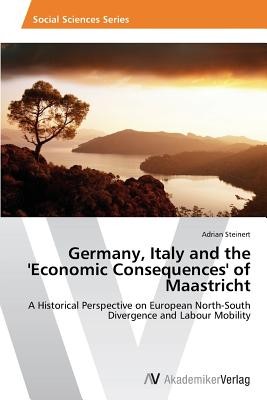
- We will send in 10–14 business days.
- Author: Adrian Steinert
- Publisher: AV Akademikerverlag
- Year: 2014
- Pages: 52
- ISBN-10: 3639633199
- ISBN-13: 9783639633191
- Format: 15.2 x 22.9 x 0.3 cm, minkšti viršeliai
- Language: English
- SAVE -10% with code: EXTRA
Germany, Italy and the 'Economic Consequences' of Maastricht (e-book) (used book) | bookbook.eu
Reviews
Description
As a result of the Maastricht Treaty, North and South Europe share with each other the single market with the free movement of capital, labour, goods and services, and the single currency. The current situation, where the European South (Greece, Italy, Portugal and Spain) is much more affected by the consequences of the economic and sovereign debt crisis than the European North (Austria, Finland, Germany, Netherlands) points at the issue of divergence within a common currency framework. 'Economic dualism' can be present as much within a country as between countries. It is demonstrated by historically evolved regional divides in Belgium, Germany, Italy, Spain or the United Kingdom. By taking Germany and Italy as case studies, this book is about European convergence and divergence from the point of view of comparative economic history. Based on a simple model of intra-regional divergence, in which labour mobility plays a key role, the development record of Eastern Germany after reunification and the Mezzogiorno since the 1950s will be compared. Their historical experiences could provide important insights into current trends within the eurozone.
EXTRA 10 % discount with code: EXTRA
The promotion ends in 22d.02:38:43
The discount code is valid when purchasing from 10 €. Discounts do not stack.
- Author: Adrian Steinert
- Publisher: AV Akademikerverlag
- Year: 2014
- Pages: 52
- ISBN-10: 3639633199
- ISBN-13: 9783639633191
- Format: 15.2 x 22.9 x 0.3 cm, minkšti viršeliai
- Language: English English
As a result of the Maastricht Treaty, North and South Europe share with each other the single market with the free movement of capital, labour, goods and services, and the single currency. The current situation, where the European South (Greece, Italy, Portugal and Spain) is much more affected by the consequences of the economic and sovereign debt crisis than the European North (Austria, Finland, Germany, Netherlands) points at the issue of divergence within a common currency framework. 'Economic dualism' can be present as much within a country as between countries. It is demonstrated by historically evolved regional divides in Belgium, Germany, Italy, Spain or the United Kingdom. By taking Germany and Italy as case studies, this book is about European convergence and divergence from the point of view of comparative economic history. Based on a simple model of intra-regional divergence, in which labour mobility plays a key role, the development record of Eastern Germany after reunification and the Mezzogiorno since the 1950s will be compared. Their historical experiences could provide important insights into current trends within the eurozone.


Reviews